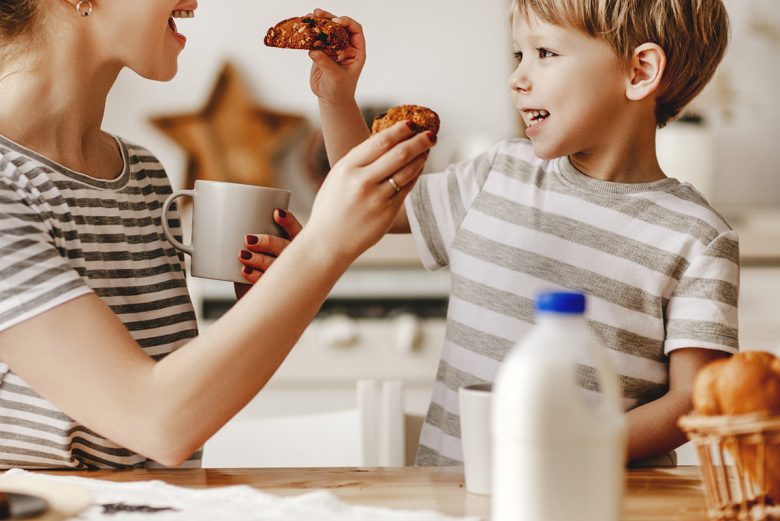
For the child who is all about comfort food.
Do you have a child with a particular palate? These sensitive eaters can use parental support to help them have a healthy connection with food.
In this episode, Carol and Anne share common tendencies of Type 2 children at mealtimes. You’ll learn tips to support them in trying new foods and communicating their needs—as well as some meal-planning insight for the Type 2 adults in your house.
This episode’s Parenting Practice
Listen to this week’s episode and notice which tip stands out to you for your Type 2 child (or yourself if you’re a Type 2). Then practice that tip throughout the week when your child sits down to eat. See what a difference it makes!
Transcript of podcast episode
Carol: Welcome to The Child Whisperer Podcast. I’m your host, Carol Tuttle, author of the best-selling parenting book, The Child Whisperer. I’m with my co-host, Anne Tuttle Brown.
Anne: We’re talking about eating tendencies for the Type 2 child today. And before we jump into the specifics, let’s review the movement. The Type 2 child has an emotional connection to the world. They are the sensitive child, they have a soft, fluid-flowing movement. And so the keywords we wanna remember today will be comfortable and sensitive. So we have a couple questions we’re going to answer about the Type 2 child and their experience. And then we’ll also speak to the Type 2 parent and their tendencies when it comes to meal planning. So I’ve got Carol here with me.
Carol: I’ve raised two Type 2 children, you’re one of them.
Anne: Yeah.
Carol: What would you say are some of the challenges you deal with, with Type 2 children first, that when it comes to eating and their behavior around mealtime?
Anne: Well, I’d like to hear what your experience was, too. Because I know that I varied from my Type 2 brother. But…
Carol: Yeah, you were both very different. I don’t recall you having much of…you were real adaptable, and you like food.
Anne: Yeah, I feel like I’ve always been pretty easy with food.
Carol: You’re a foodie.
Anne: I’ve never been too sensitive to anything. I definitely, I have developed over the years of really intuitive eating and meaning…like, I know what I like and what sounds good, and that’s what I want to eat, and kind of developing listening to my body. And I think that’s a very Type 2 quality to connect. And I can see how I did that when I was little, like, really being drawn to what sounded good.
Carol: Yeah. Something that you have in common with my mother was you always want to taste what anybody ever has.
Anne: Oh, I love samples.
Carol: You want the little taste.
Anne: Yes. Give me all the samples, just a big plate of samples.
Carol: Oh yeah, you’ve been missing the sample world went away in 2020. You’re like, “Are you bringing it back?” So you know, your child might like to taste. They’re either going to fall on one side of that or the other. Your brother and your son…
Anne: My Type 2 son, yep.
Carol: …they’re not open to trying new tastes and new things.
Anne: Not as readily, no.
Carol: He wasn’t, as a child. That’s the thing. Chris now is an adult, maturing. So we’ve learned some things, watching the tendencies change that he is now open to trying new things. He still has a few things that he just does not like.
Anne: Preferences, yeah.
Carol: But his palate has definitely broadened since he was a kid, but he was the one that is just, he wouldn’t try.
Anne: So with my Type 2, 5-year-old, since he was about 3, he has been very particular. And I specifically say particular about food, not a picky eater.
Carol: Yeah, I teach that in The Child Whisperer, not to use the phrase “picky” but “particular.”
Anne: Yeah, I try to be more sensitive to that. He’s very particular. He knows what he likes. And so he doesn’t like chocolate, and he just has never liked it. Which is actually great because it reduces the amount of sweets that he eats, that he loves.
Carol: He’s not a real sweets person, anyway.
Anne: No. Yeah, but then he loves Indian food.
Carol: And neither is his cousin, Addie, who is a Type 2. She’s not into the sweets much. But comfort food, it’s like candy, where she might like, certain…it’s sort of in that word comfort, what are their go-to comfort food.
Anne: His only flavor he likes is vanilla ice cream. He likes a green smoothie, though. He has a very…a certain flavor and brand that he likes in yogurt that he will eat. But then he likes the sharp cheddar cheese, mac and cheese, you know. So it kind of is like, well, you’re not just like in this category of chicken nuggets and hot dogs, you know.
Carol: Although he does like hotdogs.
Anne: Yes. I got to the point where I was like…
Carol: He’s a big bacon eater.
Anne: …”Fine, you’ll have a hotdog every day for lunch.” Like it was a very hard moment in my life.
Carol: Does he have a hotdog every day for lunch?
Anne: No, he kind of had too many, I think. He’s not as drawn to them anymore.
Carol: There you go, overdo the one key things they’ll eat, force him to eat a hotdog at every meal.
Anne: No. Honestly, it’s been a huge challenge for me. And so as I’ve gained understanding, and that’s why one of the keywords is sensitive, I’ve realized he has a more sensitive palate. I think his taste buds and his smell senses are heightened. And so…because he’ll notice things in flavors, like I made homemade ice cream once and I always put maple syrup in it. And I think one time I put a little bit more than I usually do, and he’s like, “This is too syrupy.”
Carol: So that’s your sweetener you use?
Anne: Yeah.
Carol: And he, really that stood out for him?
Anne: Yeah. And so I’m like, “You…” In a couple other experiences I’ve had have just made me realize you have a very sensitive taste bud, and I think the research that I’ve done is you kind of grow into that or out of that as you get older, and get more familiar with the different tastes. So rather than just being like because there have been times where I’ve just, “You’re so stubborn. You just need to eat that food, just three bites,” and it’s been a battle. I’ve just let go of that completely and I try to have…
Carol: Because that’s what mealtime now becomes. So let’s… The first question is, what is your child’s behavior at the table?
Anne: As a Type 2, very well mannered.
Carol: There’s no time. But you can go into that, “I’m not eating that,” becomes the thing.
Anne: But you know, he’s always been very pleasant. He’s not like, “I don’t want this, I need something.” It’s just like, “No, I’m not going to eat…” He’ll just kind of…he’ll not go for it. And so it’s…even in his, like, refusal to eat has been…
Carol: If a parent’s really stuck on that and insists that they eat it, now the parent can become very unpleasant and stress the child out.
Anne: I guess we’re kind of we’re hitting two… If you have a particular/picky eater, this would be a good podcast to listen to because we’re kind of hitting the Type 2, and we’re also going into this because that’s my personal experience…
Carol: Yeah, well, the two Types that tend to have this tendency are Type 2s and Type 4s children more than any other kid.
Anne: Yeah, yeah. I remember one time, you know, I talked to friends or I’d read things and be like, “What should I do with my son, he’s just so particular about what he eats?” “Just make him eat three bites,” was always the thing. And I was like, “Tried that.” I’m like, “I can’t. He won’t do it.”
Carol: Yeah, he won’t even do the three bites, yeah.
Anne: Yeah, so I’ve just let go of that. And, you know, I try it. I even say, “Well, why don’t you just smell it? Or why don’t you just put it in your mouth for a second?”
Carol: Will he do that?
Anne: Yeah, sometimes he’ll smell it. He’s open to that. Smell it, touch it with your fork, like…and in this, I’m trying to familiarize him with this. And he’s seeing his siblings eat it. He’s seeing all of us eat it. It’s at the table in front of him. And then recently, he tried some…I made some French dip, he really liked the beef. And he tried it again, and he’s like, “Oh, that’s my favorite.” And I’m like, “Oh, great. Have some more.” Trying to play it cool.
Carol: Well, your position on it is what when you make it a big deal, and you have to…and you insist that he have more variety, it’s gonna be stressful. What shifted this was your willingness to be more aligned with what his preferences are right now and work within that and not make it such a big…you know.
Anne: There came a point where it’s like, “Okay, if I make,” he doesn’t like soup, so if I make a soup and some…and for dinner, like, what is he going to eat? Because I don’t want to be making him mac and cheese, there’s that, you know. And so what I’ve done is I’ve just kind of expanded what I offer on the table, I bring yogurt, or fruit or toast and kind of more options, nuts, for the whole family. And I know that, “Okay, in that mix…
Carol: He’ll choose some things.
Anne: …there will be something that he will choose.”
Carol: And the thing that will happen if a child is experiencing this stress at mealtime or at the dinner table, it may not come out clearly in that moment, but they may become more whiny in other scenarios. Because see, Type 2 children don’t have an immediate response always with their emotional experience. It can be delayed, it can take some time. And so they don’t even know the reason they’re whiny throughout the day is because they’re feeling…they’re experiencing so much stress around eating and food. And it’s just a pressure they’re dealing with. So it’s not always evident in the exact moment of this stress scenario. So if you’ve got a whiny… Type 2 children will whine more than other children. And they use it as a way to get their way, but they also, it’s a sign, a signal something’s stressed in their world, and it may not be that very moment you’re hearing the whine.
Anne: Yeah, it’s a good point.
Carol: And you’ve got to step back and go look at their whole day, where’s their pressure coming from? Where are they feeling this pressure? Discomfort, the lack of comfort.
Anne: And to kind of go along with that comfort, and what is the experience at the dinner table? Are they feeling connected to the family? Are they being able to engage in conversation with the parents and the siblings? And I’d say also, they will take a little bit longer to eat, just naturally as Type 2s, like I’m always the last one to finish in my family, as a Type 2. And so giving them that time, “Do you need more time?” Rather than, “Hurry up and eat.”
Carol: Type 3s will be the first to finish. The other…you had mentioned this before we started recording, that it’s common for the adults at the table or the two parents to engage in conversation matters that are pertinent in their world and they’re connecting. And they haven’t seen each other possibly throughout the day, and the children aren’t engaged in the conversation. So I think that would be really valuable to notice, “Let’s save our conversation for after dinner. You know what? Let’s engage our entire family, let’s connect with everybody.”
Anne: I’ve definitely fallen into that tendency sometimes. And my objective has been let’s connect as a family. Let’s connect as a family. And so coming up with conversation starters, or questions to ask…
Carol: So I would think Sam looks forward to dinner.
Anne: Oh, sometimes we’ll play this game, what would you…if you could go anywhere in the world, where would you go? If you can be any animal, what would you be? And he loves that game. He always chooses, you know, Africa and a lion.
Carol: So he’s not real motivated by food. Food isn’t showing to be a big thing in his world. Like, “I love food.” Like you loved… You still love tasting, like, food’s enjoyable for you. Food is more of he’s learning how to eat and make choices, a part of his daily, you know, supporting himself, but it’s this, what you’ve created in your culture of the dinner time that he’s drawn to that. He loves dinner not because, “Oh boy, I get to eat this.” It’s…
Anne: Yeah, I will say…
Carol: …”I need to have that experience and connect with my family.”
Anne: He’s a really good breakfast eater. He loves pancakes, waffles, bacon, eggs and bacon.
Carol: Those are all comfort food.
Anne: Yes. And he eats a big breakfast consistently every day.
Carol: That’s good.
Anne: And he doesn’t like syrup. He just likes lots of butter. So it’s great. But you know, so it’s…like, I’ve noticed that like, “Okay, well, let’s make sure you get really good breakfast to be able to fuel you, you know, because you may not eat a lot of dinner tonight.”
Carol: You know, I don’t think that’s a issue that your child doesn’t like sugary foods.
Anne: No, it’s great.
Carol: That’s a bonus from all of this.
Anne: And I make sure to get the extra quality butter because I know he’s going to eat a lot.
Carol: Right, grass-fed butter.
Anne: Yep. Let’s talk now about the Type 2 parent and their tendencies.
Carol: Hold that thought. Let’s continue this discussion after a short break.
*
Woman’s voice: What’s your mom uniform? Yoga pants? Jeans and a T-shirt? As a mom, you’re busy, and wardrobe isn’t high on the priority list. But do you ever get tired of feeling blah about how you look? Carol Tuttle’s Dressing Your Truth program helps you create a personal style that works for you, for your budget, for your family, and for your life. You can look more pulled together in less time. All you need is a little know-how, and Carol can show you. Just sign up for a free account at dressingyourtruth.com.
*
Anne: As I Type 2 myself, I am a good meal planner, when I feel like it. I’ve gotten to the place where sometimes I’ll really get detailed and planned out, and sometimes I’ll just, you know, grab a pound of beef, some chicken breast, see what I have in the fridge and be like, “Okay, things will come to me during the week. I’ve cooked enough meals in my life, I’ll know what to do as, kind of, our week unfolds, if it’s a little busier.”
Carol: You would… I’ve seen where…see, you just shared you had to make…you had to change things up with Sam because, see, you have this plan in your mind. And this is how your child needs to eat, and you’ll get too stuck on that.
Anne: Yeah, that can be a sticking point, yeah.
Carol: That is the challenge right there, is this what you’ve put together is you do, you learn, you read, you…
Anne: I’ve prepared this, I’ve planned this, and I know this is what you’re going to need to eat.
Carol: Exactly, and you’re eating it.
Anne: And this what we’re going to make. Because I put too much effort into it. So I think in my early years…
Carol: And you then will learn from as far as what are dietary needs for children and, “I need to implement…” Like see, you have all this information and ideal in your head…
Anne: Yeah, I’ll stress out because… Yep
Carol: …that this is what needs to happen. And so you get stressed when it’s not happening. It’s like your child’s not cooperating with your plan.
Anne: I’ve had to become more flexible and broaden my plans.
Carol: Yeah, and not make certain things so important that you previously thought, “Well, my child needs more than a hotdog every day at lunch.”
Anne: I do buy the organic ketchup with added veggies and he didn’t notice. I was so happy when I gave him the ketchup, there’s a new brand that has like carrot and butternut squash puree.
Carol: Vitamin C added? No.
Anne: No, no, but I was like, “Is he going to like it?” “He likes it.”
Carol: I always say carry the healthy multivitamin when necessary.
Anne: Yes, I’ve been doing that.
Carol: Because honestly…
Anne: Yeah, as a parent, you just have to let go and be like, “Okay, you’re going to figure this out. Your body knows what’s best, I trust.”
Carol: You didn’t surrender, like just whatever, you worked within it. You made changes. Again, you tweaked it so that it’s doable.
Anne: And I still am, you know, he loves chicken nuggets and so I’ve been buying different brands that are organic or healthier and like taste-testing and kind of, you know, my tendency too is to be like, “Okay, we’re just going to revamp it all.” Like starting now, it’s like…
Carol: New plan.
Anne: …I’ve got to take this little bits at a time, like I’m dealing with this sensitive Type 2, yeah.
Carol: You’ve got to be adaptable with ghee or… So you still have the bigger plan in mind and that, you know, the methodical about… And in your meal planning, are you doing the whole week, the whole month? Like, what does that look like yearlong?
Anne: I’ve gone different ways. Like there was a time where I did do like the whole month. I really wanted to decrease the amount of time I was at the grocery store. So I try and shop ahead. And now I’m kind of like just weekly. And I kind…
Carol: So you know what you’re doing the week. When do you…do you sit, do you just do it in your head? Or do you actually write it out?
Anne: Usually, I like to write it down.
Carol: You do.
Anne: Even if it’s just, you know, quick ideas and not assign dates, but like these are the…usually, I’ll end up making four or five meals a week. And so these are the ones.
Carol: Yeah, and not necessarily this will happen on Monday. But you know your schedule for the week and which meals will…?
Anne: Yes.
Carol: How are you about eating out? You know, the whole eating out thing changed quite a bit in 2020. Are you much of a… Do you plan in that a couple times?
Anne: I like to because…
Carol: You go out. What do you do with that?
Anne: Yeah, I mean, we have the spots where everybody likes to go as a family that are quick and… I usually plan once a week to eat out or to, like, bring takeout home just to kind of lighten my load, and to plan that. And then we usually do a date night. So the kids are just doing something simple and easy. In my earlier years of marriage, you know, just kind of figuring out meal planning and prep, I would try something new every night and want to get all the fixings and make it really fancy and detailed. And it was getting really difficult. It was frustrating. It was taking so much time, and my Type 3 husband sat down with me and he’s like, “What are the best meals that you can make quickly? Let’s make those more often.” I think he was overwhelmed by the amount of dishes I was creating.
Carol: Your role model was not…I mean, hello.
Anne: Yeah, you’ve been a great, great role model and great teacher to me about how to create healthy, quick, simple meals.
Carol: Yeah, meals have never been a cha-… I was a home ec teacher.
Anne: So yeah, so just kind of, as a Type 2, if you’re feeling that overwhelm, reevaluate your plan, how can you simplify, and what can you let go of? Your parenting practice for this week is what can you implement to tweak things to create a better food experience for yourself, if you’re a Type 2 parent, or your Type 2 children?
Carol: Thanks for listening. For more support, go to thechildwhisperer.com where you can purchase the book, subscribe to our weekly parenting practice email, and find a transcription and audio of “The Child Whisperer” podcast.
Anne: If you’re listening on iTunes, thank you for leaving a review. If you have a parenting question, please send it to [email protected].



